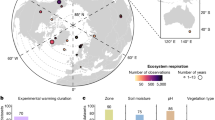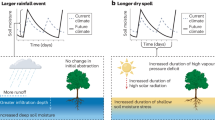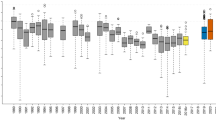Abstract
Terrestrial ecosystems control carbon dioxide fluxes to and from the atmosphere1,2 through photosynthesis and respiration, a balance between net primary productivity and heterotrophic respiration, that determines whether an ecosystem is sequestering carbon or releasing it to the atmosphere. Global1,3,4,5 and site-specific6 data sets have demonstrated that climate and climate variability influence biogeochemical processes that determine net ecosystem carbon dioxide exchange (NEE) at multiple timescales. Experimental data necessary to quantify impacts of a single climate variable, such as temperature anomalies, on NEE and carbon sequestration of ecosystems at interannual timescales have been lacking. This derives from an inability of field studies to avoid the confounding effects of natural intra-annual and interannual variability in temperature and precipitation. Here we present results from a four-year study using replicate 12,000-kg intact tallgrass prairie monoliths located in four 184-m3 enclosed lysimeters7. We exposed 6 of 12 monoliths to an anomalously warm year in the second year of the study8 and continuously quantified rates of ecosystem processes, including NEE. We find that warming decreases NEE in both the extreme year and the following year by inducing drought that suppresses net primary productivity in the extreme year and by stimulating heterotrophic respiration of soil biota in the subsequent year. Our data indicate that two years are required for NEE in the previously warmed experimental ecosystems to recover to levels measured in the control ecosystems. This time lag caused net ecosystem carbon sequestration in previously warmed ecosystems to be decreased threefold over the study period, compared with control ecosystems. Our findings suggest that more frequent anomalously warm years9, a possible consequence of increasing anthropogenic carbon dioxide levels10, may lead to a sustained decrease in carbon dioxide uptake by terrestrial ecosystems.
This is a preview of subscription content, access via your institution
Access options
Subscribe to this journal
Receive 51 print issues and online access
$199.00 per year
only $3.90 per issue
Buy this article
- Purchase on Springer Link
- Instant access to full article PDF
Prices may be subject to local taxes which are calculated during checkout



Similar content being viewed by others
References
Keeling, C. D., Chin, J. F. S. & Whorf, T. P. Increased activity of northern vegetation inferred from atmospheric CO2 measurements. Nature 382, 146–149 (1996)
Schimel, D. S. Terrestrial ecosystems and the carbon-cycle. Glob. Change Biol. 1, 77–91 (1995)
Myneni, R. B., Keeling, C. D., Tucker, C. J., Asrar, G. & Nemani, R. R. Increased plant growth in the northern high latitudes from 1981 to 1991. Nature 386, 698–702 (1997)
Randerson, J. T., Thompson, M. V., Conway, T. J., Fung, I. Y. & Field, C. B. The contribution of terrestrial sources and sinks to trends in the seasonal cycle of atmospheric carbon dioxide. Glob. Biogeochem. Cycles 11, 535–560 (1997)
Vukicevic, T., Braswell, B. H. & Schimel, D. A diagnostic study of temperature controls on global terrestrial carbon exchange. Tellus 53B, 150–170 (2001)
Law, B. E. et al. Environmental controls over carbon dioxide and water vapor exchange of terrestrial vegetation. Agric. Forest Meteorol. 113, 97–120 (2002)
Griffin, K. L. et al. EcoCELLs: Tools for mesocosm scale measurements of gas exchange. Plant Cell Environ. 19, 1210–1221 (1996)
Verburg, P. S. J., Larsen, J. D., Johnson, D. W., Schorran, D. E. & Arnone, J. A. Impacts of an anomalously warm year on soil CO2 fluxes in experimentally manipulated tallgrass prairie ecosystems. Glob. Change Biol. 11, 1720–1732 (2005)
Easterling, D. R. et al. Climate extremes: Observations, modeling, and impacts. Science 289, 2068–2074 (2000)
Intergovernmental Panel on Climate Change. Climate Change 2007: The Physical Science Basis: Fourth Assessment Report of the Intergovernmental Panel on Climate Change (Cambridge Univ. Press, 2007)
Braswell, B. H., Schimel, D. S., Linder, E. & Moore, B. The response of global terrestrial ecosystems to interannual temperature variability. Science 278, 870–872 (1997)
Tian, H. Q. et al. Effect of interannual climate variability on carbon storage in Amazonian ecosystems. Nature 396, 664–667 (1998)
Körner, C. in Ecology of Photosynthesis (eds Schulze, E. D. & Caldwell, M. M.) 463–490 (Springer, 1994)
Bunce, J. A. Low humidity effects on photosynthesis in single leaves of C-4 plants. Oecologia 54, 233–235 (1982)
Oren, R. et al. Survey and synthesis of intra- and interspecific variation in stomatal sensitivity to vapour pressure deficit. Plant Cell Environ. 22, 1515–1526 (1999)
Wever, L., Flanagan, L. B. & Carlson, P. J. Seasonal and interannual variation in evapotranspiration, energy balance and surface conductance in a northern temperate grassland. Agric. For. Meteorol. 112, 31–49 (2002)
Grace, J., Lloyd, J., Miranda, A. C., Miranda, H. & Gash, J. H. C. Fluxes of carbon dioxide and water vapour over a C-4 pasture in south-western Amazonia (Brazil). Aust. J. Plant Physiol. 25, 519–530 (1998)
Vourlitis, G. L. & Oechel, W. C. Eddy covariance measurements of CO2 and energy fluxes of an Alaskan tussock tundra ecosystem. Ecology 80, 686–701 (1999)
Novick, K. A. et al. Carbon dioxide and water vapor exchange in a warm temperate grassland. Oecologia 138, 259–274 (2004)
Saleska, S. R., Harte, J. & Torn, M. S. The effect of experimental ecosystem warming on CO2 fluxes in a montane meadow. Glob. Change Biol. 5, 125–141 (1999)
Rustad, L. E. et al. A meta-analysis of the response of soil respiration, net nitrogen mineralization, and aboveground plant growth to experimental ecosystem warming. Oecologia 126, 543–562 (2001)
Ciais, P. et al. Europe-wide reduction in primary productivity caused by the heat and drought in 2003. Nature 437, 529–533 (2005)
Reichstein, M. et al. Reduction of ecosystem productivity and respiration during the European summer 2003 climate anomaly: a joint flux tower, remote sensing and modelling analysis. Glob. Change Biol. 13, 634–651 (2007)
Knapp, A. K., Briggs, J. M. & Koelliker, J. K. Frequency and extent of water limitation to primary production in a mesic temperate grassland. Ecosystems (N. Y., Print) 4, 19–28 (2001)
Suyker, A. E., Verma, S. B. & Burba, G. G. Interannual variability in net CO2 exchange of a native tallgrass prairie. Glob. Change Biol. 9, 255–265 (2003)
Schimel, D. S., Churkina, G., Braswell, B. H. & Trenbath, J. in A History of Atmospheric CO2 and its Effects on Plants, Animals and Ecosystems (eds Baldwin, I. T. et al.) 350–368 (Springer, 2005)
Acknowledgements
We thank E. Kessler and the University of Oklahoma for the use of the Kessler Farm Field Laboratory; R. Kreidberg for editorial assistance; and J. Amthor, M. Bahn, C. Körner, D. Obrist and G. Wohlfahrt, for critical review of an early draft of this manuscript. This study was funded by the US National Science Foundation’s Integrated Research Challenges in Environmental Biology program, with additional support from the Desert Research Institute (DRI) for necessary upgrades to the EcoCELL facility. We are very grateful to DRI, the University of Oklahoma, and the University of Nevada–Reno teams for technical assistance, facilities support, and administrative expertise (also see Supplementary Information).
Author Contributions J.A.A. and P.S.J.V. headed up the study including leading proposal writing, project coordination, data interpretation and analysis, and manuscript preparation. P.S.J.V., R.L.J., J.D.L., D.E.S., J.A.A. and W.G.C. were directly involved in all aspects of the study on a day-to-day basis, with A.J.L., J.A.A., L.L.W. and R.A.S. focusing on plant community aspects; C.M.B. contributing to hydrological measurements; J.D.L. contributing to quantification of plant canopy dynamics; P.S.J.V. contributing particularly to measurements of soil CO2 fluxes and soil C and N; and D.W.J. contributing to estimation of soil nutrients. D.S.S., Y.L., B.H.B., J.S.C., P.S.J.V. and J.A.A. developed the idea for the research. C.v.N. built and managed the database for the project and contributed to data analyses. P.E.B. coordinated outreach activities to local schools and brought research to the communities of Reno and Las Vegas. R.L.J., J.D.L. and P.S.J.V. worked closely with J.A.A. on data analysis and manuscript preparation. All authors discussed the results and commented on the manuscript.
Author information
Authors and Affiliations
Corresponding author
Supplementary information
Supplementary Information
This file contains Supplementary Methods, Supplementary Text, Supplementary References, Supplementary Table 1 and Supplementary Figures 1-8 with Legends (PDF 6448 kb)
Rights and permissions
About this article
Cite this article
Arnone III, J., Verburg, P., Johnson, D. et al. Prolonged suppression of ecosystem carbon dioxide uptake after an anomalously warm year. Nature 455, 383–386 (2008). https://doi.org/10.1038/nature07296
Received:
Accepted:
Issue Date:
DOI: https://doi.org/10.1038/nature07296
This article is cited by
-
Temperature extremes of 2022 reduced carbon uptake by forests in Europe
Nature Communications (2023)
-
Simulated heat wave events increase CO2 and N2O emissions from cropland and forest soils in an incubation experiment
Biology and Fertility of Soils (2022)
-
Nonadditive and Legacy Effects of Spring and Autumn Warming on Soil Respiration in an Old-Field Grassland
Ecosystems (2021)
-
Accelerated dryland expansion regulates future variability in dryland gross primary production
Nature Communications (2020)
-
The full annual carbon balance of a subtropical coniferous plantation is highly sensitive to autumn precipitation
Scientific Reports (2017)
Comments
By submitting a comment you agree to abide by our Terms and Community Guidelines. If you find something abusive or that does not comply with our terms or guidelines please flag it as inappropriate.



